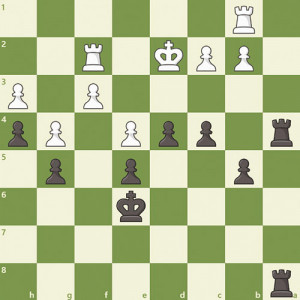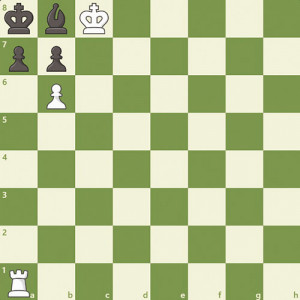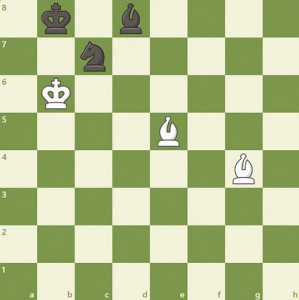
In chess, Zugzwang, German word meaning a compulsion to move, is a moment in the game when it is one side’s turn to go but any move they make will result in a loss. This concept is evident in the position shown in Figure 1, which utilizes the idea of opposition. This opposition is an example of Zugzwang that is key to king and pawn endgames, in which one moves their king forward to cut off squares, forcing the opponent to move their king away so one can then push their king further and win the game.
Here, if it were black, to move the game would be a simple draw as black can bring the king forward and white cannot penetrate the position and achieve a pawn promotion. However, with white to move, white can play king to e5, a move that blocks the black king from coming forward and, employing the idea of Zugzwang, forces it to move to the side or backward. For example, if black moves the king to f7 after king to e5, white then moves the king to d6, further cutting off the black king and walking toward the pawn on b6, which black cannot prevent from being captured. If the black king instead goes to d7, white then uses opposition again and plays king to d5, forcing the black king either to the right, which allows the white king to get to black’s b pawn or to the left with Kc7, which allows Ke6 Kc8 – Kd6 Kb7 – Kd7 and white to continually oppose the black king until the b6 pawn is won.

Figure 2 is a position from an exhibition game played in 1911 between Leopoldo Carranza playing white and Jose Capablanca, the third world chess champion and one of the greatest players of all time playing black. First, black played 1. Ra1, forcing a rook trade to simplify the position into a more simple, winning endgame where he is completely restricting Carranza’s play…Rf1 2. Rxb1 Rxb1 3. Ra2, activating the rook and adding more pressure to white’s pawns. Because his position is so confined, white simply plays…Kd1, and then, very instructionally, Capablanca continues to bring his pieces forward and constrict white by playing 4. b4 Kd2 5. Kd6 Kd1 6. Kc5. By advancing his king, pawns and rook into white’s cramped position, Capablanca prepares to break through with his pawns and win the game. Attempting to prevent this, white plays…b3 but black keeps with position locked with 7. c3 Rc1. Now, take a moment and try to find the brilliant winning move that black played: 8. d3, threatening to push the pawn to d2 and if white captures it with…cxd3 which was played in the game, Capablanca understood that white, despite being up a pawn, is in Zugzwang and cannot defend his position after 9. Rh2 Rc2 10. Rh1+ Ke2 11. Kd4. Here, white resigned as every move loses immediately: moving his king forward to f2 or rook back a2 allows black to play Rh2+ with a skewer that forces white to move his king and black can win the rook. All other rook moves lose the rook and…f4 fails to 12. Rh2+ Kd1 13. Rxc2 Kxc2 14. exf4, culminating in an easily winning endgame for black as the swift promotion of black’s f or c pawns cannot be prevented.
Figure 3 is a famous position created by Paul Morphy, the American chess legend of the 1800s. Here, the only move for white that checkmates black in 2 moves is Rook to a6, an idea that puts black completely in Zugzwang so that every possible move for black loses. The rook has to go to a6 specifically to prevent black from being able to move the a pawn and keeps the a pawn pinned to the king so it can’t capture white’s pawn on b3. If black captures the rook with bxa6, white can then push the pawn to b2, mating the black king in the corner of the board. If, instead of taking the rook, black moves the bishop, white can take the a7 pawn with his rook, also checkmating the black king.
The position shown in figure 4 is an endgame composition by Goldberg published in 1931 in which white must find a specific line using Zugzwang to checkmate black in an otherwise drawn endgame. Utilizing the fact that neither black’s bishop or knight can move as the knight is pinned to the king and the bishop is stuck guarding it, white must first play the only move bishop to d7. This square is key because it prepares to check the king on the h1-a8 diagonal after black moves his king to a8 while still covering the c8 square. If white were to attempt the same idea but farther back, for example moving the bishop to h3, after king to a8 and bishop to g2 check, black can block with Nd5, a move that opens up a discovered attack from the bishop on d8, checking the white king and securing a draw. After bishop to d7 and king to a8, white must then play bishop to c6 check, forcing the black king back to b8 and then play the bishop to b7. This is the crucial winning move as it places black in Zugzwang; the king lacks any legal moves and the knight is pinned so the bishop must move and leave the knight undefended. After any of the forced bishop moves, white has bishop takes on c7 with checkmate.

Ethan Feder is a junior at Yeshivat Frisch in Paramus and a chess enthusiast and player. The goal of his column is to teach and discuss chess concepts through example positions, high-level games and relevant puzzles, along with explanations. Feel free to contact him with any questions, suggestions or comments at [email protected].














